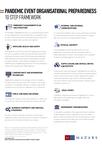Organisational resilience: responding to the unknown
Q. What can a business do in the first instance?
Ensure employees know that the business is doing everything within its power to protect their health and the health of their families. Employees are more likely to assist the organisation during a disruption or pandemic event once they and their families feel protected. Effective employee health and safety planning includes pre-event implementation of health education activities, monitoring and managing of workforce readiness, and strengthening partnerships with local emergency medical services and public health agencies.
It also includes protecting critical supplies, securing vacated properties, and guarding against social disruption.
Meanwhile, keep calm and communicate that the organisation has a plan for this kind of event and will be implementing it at once. If you have planning documents, do not try any activities that are outside their scope, unless there is a danger to employee health and well-being.
Q. What commercial considerations should leaders prioritise?
Most businesses should start with their cash flow: come up with strategies and plans based on different scenarios – how long the disruption might last, and what commercial disruption your business faces in particular.
Look at your ecosystem and see what’s possible:
- Review the benefits available from your local governments and unions, and apply for assistance
- Review current accounts receivable (if applicable) and request payment
- Review vendor payable listing and have essential and non-essential payments- discussions with vendors
- Prepare 13 and 26-week cash flow projections and proactively review with the bank
- Prepare a direct and non-direct spend analysis
- Isolate non-essential spend
- Apply for, or draw on, available funds.
- If possible, look for alternative forms of revenues: for example, manufacturers pivoting to build ventilators and restaurants doubling down on food deliveries
Q. What’s your advice for keeping employees motivated?
When possible, have employees work remotely. If they are unable, consider if their functions are critical to business operations. If they are not, send them home but offer ways to keep them engaged, for example by undertaking research in their areas, training classes, or serving as part of the organisational communications team for the pandemic.
To keep employees’ morale up, do not send out daily emails or messages outlining the current state of the pandemic event (this can have a huge psychological impact on individuals, especially if they live alone), additionally, they can search the internet to find out any information about the pandemic event. Instead, supply a portal of some kind where employees can view information about the organisation’s response and activities about the pandemic event on their own terms.
Q. What are some key communications concerns?
In times like this, the availability of leaders is incredibly important. Leaders should be online and available as much as possible to narrow any perceived distance between team members.
While leaders can certainly provide guidance as the most effective ways to reach them, every effort must be made to acknowledge communications as quickly as possible no matter what channel the communication comes across. In the event a leader can’t respond to a request, they should provide a manageable timeline and if leaders haven’t heard from their team members every other day or so, they should reach out to check in.
Some Mazars offices have recently created digital channels where people can share ideas and tips on how to practice mental and physical selfcare; it’s also a great forum to highlight some of the positive things that the firm is achieving as we work remotely.
Q. How can they prepare for long-term disruption?
If the organisation has business continuity plans, they need to be activated now. This will activate the procedures to continue critical business functions. Also, regularly check in with employees who are at remote locations: ask how they are doing, and ask about their state of mind and their family’s health; encourage employees to report any change in health status at once; and develop a tracking mechanism that will allow the organisation to have up to date knowledge of the state of the workforce.
As for operational aspects, leaders need to spend time modelling different cashflow scenarios, and possibly delaying strategic investments and making difficult team decisions.
If remote working looks like it will last longer than your current business continuity plans, consider:
- Changes in leave policies, relaxing the restrictions, such as allowing free time for necessary medical appointments
- A leave sharing programme for employees who don’t have enough leave to cover any absences
- Lessening the work week: early Fridays, alternative work schedules (four ten-hour days or a total of 80 hours across nine days.) Ensure that employees have what they need to deal with unfolding events, including employee assistance programs and an open-door policy to management.
While predictions currently vary, leaders would do well to begin factoring into business equations the possibility of domestic, and even global, recessions.
Q. What common mistakes need to be avoided in times like these?
Do not react rashly: refer to the organisation’s crisis management or pandemic event plans for instructions on how to address a crisis; ensure procedures are in place to keep employees calm and the event contained; and do not make sweeping changes to the way the organisation does business - small calculated adjustments will have a greater affect and be easier to control.
The biggest mistake can be an organisation’s leadership thinking that they have experienced this before - every event is different. Organisations should admit when they may need help and ask someone who may be more knowledgeable on the subject.
Finally, maintain both a short-term and long-term view: an organisation needs to work with what’s possible in the short-term but should not lose sight of its long-term goals, they need to be able to bounce back, when the time comes.
Contributors:
- Alisha Jernack, Senior Manager, Mazars USA
- Cary Jasgur, Manager, Mazars USA


